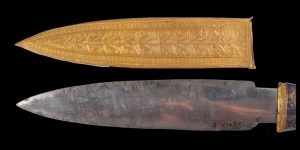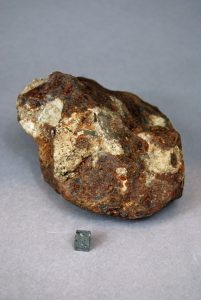
King Tuts Dagger photo by Daniela Comelli “Meteoritics & Planetary Science” (2016)
Sedona AZ (June 13, 2016) – The Verde Valley Archaeology Center will present a free talk entitled “Meteorites from King Tut to Ancient Native Americans” by its Executive Director Ken Zoll on Thursday, June 23, at 6:30 p.m., at the Sedona Public Library, 3250 White Bear Road, Sedona.
Recent news reports describe metallurgic tests which proved that the Tutankhamen iron dagger came from a meteorite. The iron-bladed dagger was found in 1925 beneath the wrappings of his mummy. Although an Egyptian hieroglyphic dated to Tutankhamen dynasty described iron as “metal from the sky” it was not until recent tests that the dagger was proved to be of extraterrestrial origin, according to an article published in the journal Meteoritics & Planetary Science. However, this discovery is not limited to ancient Egypt. The occurrence of meteorites at archaeological sites in North America has been known since the early 19th century. From the Hopewell culture in the eastern United States, to the Polar Eskimo, to the Indians in the American Southwest and northern Mexico, meteorites have been found on these ancient sites. Much like meteorite hunters of today, ancient Native American cultures actively engaged in meteorite collecting. Although we cannot know if a particular meteorite fall was ever witnessed, the discovery of meteorites at ancient sites and the artifacts made from meteoric iron appeared to have been reserved for ceremonial purposes.

Bloody Basin Meteorite photo by Ken Zoll at ASU Center for Meteorite Studies
Zoll has been working with Arizona State University’s (ASU) Center for Meteorite Studies to document the use of meteorites among ancient Native American cultures, concentrating on the four meteorites found within Sinagua ruins of Northern Arizona, including the Verde Valley. One meteorite at ASU in Zoll’s studies was found near a ruin in the Bloody Basin area of the Tonto National Forest. Unfortunately, it was found by an 8-year old so the exact location was unclear. However, small charcoal pieces embedded in the crevices of the meteorite were sent for carbon-14 dating. The results returned dates between A.D. 1355 and 1390, confirming its location to have been within the ruin. According to Dr. Laurence Garvie, Curator of the Center for Meteorite Studies, this is the first meteorite ever subjected to carbon dating to pinpoint its prehistoric location. This talk will discuss the use of meteorites among ancient Egyptians and ancient Native Americans across the United States and Northern Mexico.
The Verde Valley Archaeology Center is located at 385 South Main Street in Camp Verde, Arizona. Information about the talk is available on the Center’s website at www.vvarchcenter.org or by calling 928-567-0066.

Read www.SedonaEye.com for daily news and interactive views!


I’ve written several novels about ancient Egypt. In “Murder by the Gods” i mentioned the fact that some pharaohs managed to be buried with objects made from fallen meteorites. It is so cool to find this new discovery in Tut’s tomb as well. Great article.
planning a drive from Ctnwood & suggest go see this!